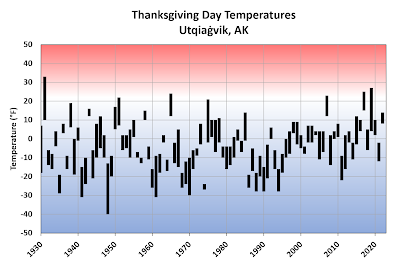Temperatures have dropped off very sharply in the last 10 days for most of Alaska, and the first well-below-zero readings have appeared in the usual cold spots. So far the Chalkyitsik RAWS is "in the lead" with -30°F yesterday morning.
This is only slightly unusual for the date: in the last 20 years, it has been typical for -20s to appear somewhere in the state by early November. Just two years ago on this date it was -40°F in Chicken.
For the state as a whole, though, the cold is unusual; it's the most significant below-normal spell for the statewide temperature index since early August. Of course, the absolute magnitude of the departure from normal is now much greater than it was in summer, because temperature variance is so much higher in the cold season.
It's worth reviewing data from the last couple of years to see how abundant "extremes" of both warm and cold have been. For background, in March 2021 I used ERA5 reanalysis data to look at the imbalance in warm versus cold extremes for (most of) Alaska's land area, and it was interesting to note that the occurrence of cold extremes had dropped off in recent years even after detrending the data. In other words, even relative to the modern warmer baseline, there had been an absence of significant cold for several years, in both summer and winter.
Note that here I'm using a threshold of 2 standard deviations above or below normal (or trend) to define an "extreme". For reference, Sunday's notably chilly high temperature of only +7°F in Fairbanks was 1.35 SD below the 1991-2020 normal; a 2 SD cold anomaly would have meant a high temperature near 0°F, or a low temperature near -18F.
Here are updated charts for the land area coverage of these warm and cold extremes in June-August, relative to a trend-line normal. The land area box includes all of Alaska west of 141°W, i.e. excluding Southeast Alaska (where ERA5 does not do well with surface temperatures because of topography).
This summer brought a notable uptick in cold extremes relative to trend, and somewhat surprisingly (because southern and southwestern Alaska were very warm in June) there wasn't an over-abundance of +2SD daily warm extremes.
Below are the equivalent charts using a fixed 1981-2020 baseline; as expected, this summer's cool extremes did not rise to the level of many years prior to 2010. I think it's also interesting to note just how severe the 2022 wildfire season was despite an excess of extreme warmth; I surmise that this is because it was driven by extreme drought, persistent but less-extreme warmth, and numerous lightning ignitions.
As for winter, the ERA5 data shows a relative lack of warm extremes in the past two winters, even relative to a fixed climatology. This certainly reflects the influence of a persistent La Niña with a negative PDO phase; these large-scale climate phenomena prevented a recurrence of the excessive warmth of 2013-14 through 2018-19.
Last winter also produced more cold extremes than in the prior 8 winters - mostly in November last year, which was the coldest November statewide since 2011. But just like this summer, overall the winter of 2021-2022 wasn't particularly unusual compared to the colder winters of earlier decades.
It will be interesting to see where we go from here. With La Niña still hanging around, there's a good chance we'll see at least some episodes of quite unusual cold in the coming months, and a return to pervasive warmth seems a bit unlikely in the near future. However, the CPC's latest seasonal forecast for December-February only hints at increased odds for significant cold in Southeast, and the warm tilt has increased since last month for western Alaska.






































